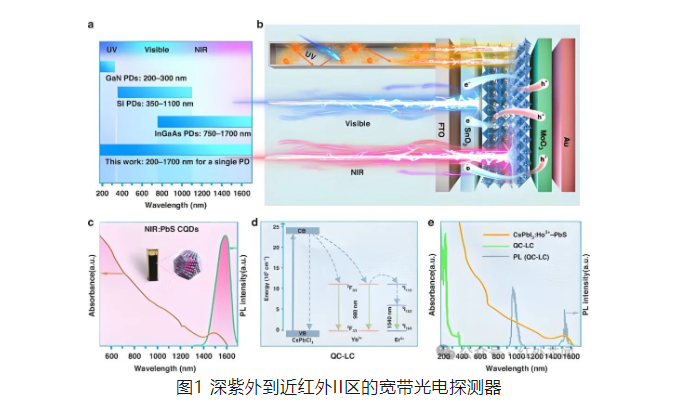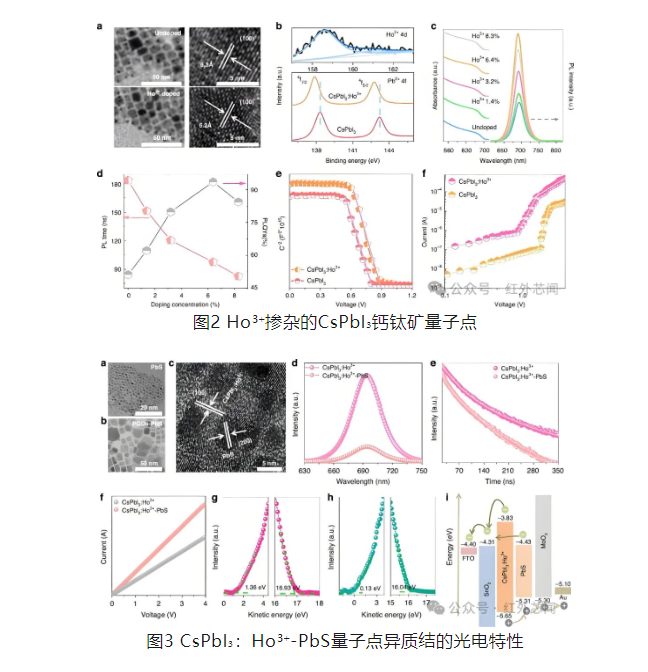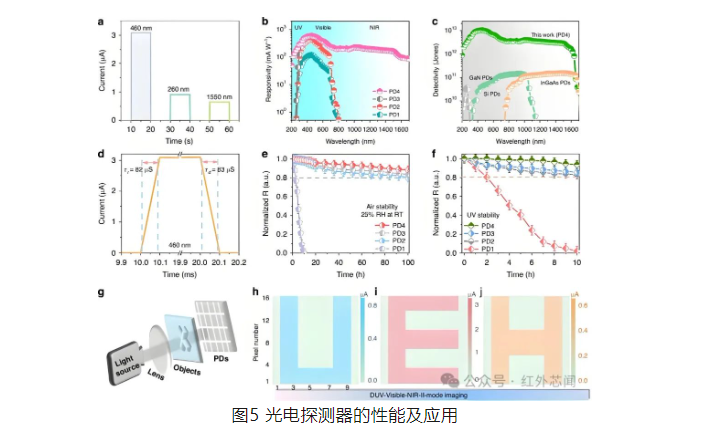31
2024
-
12
High-sensitivity quantum dot photodetectors from deep ultraviolet to near-infrared
Author:
Research on constructing heterojunction strategies to utilize the synergistic effects of materials responsive to different wavelengths, broaden detection ranges, suppress device dark current, and improve detection sensitivity has been widely reported. However, the aforementioned research mainly aims to broaden the infrared response of photodetectors, lacking theoretical and systematic in-depth exploration in aspects such as the interaction at the interface after constructing the heterojunction, charge transport relationships, device mechanical performance and stability, and the impact of heterojunction layer thickness on device performance. In addition, strategies that utilize fluorescent conversion materials to absorb deep ultraviolet-ultraviolet light and emit visible or infrared photons consistent with the photodetector response wavelength, thereby enhancing the device's ultraviolet detection performance, have received considerable attention.

To achieve high performance and broadband response in photodetectors, researchers conducted a series of optical and electrical experiments. First, to improve the performance of perovskite quantum dots, lanthanide element ions (Ho³⁺) were selected as dopants and incorporated into CsPbI₃ perovskite quantum dots prepared by an improved hot injection method, with relevant test results shown in Figure 2. Next, researchers performed optical and electrical analysis of the CsPbI₃:Ho³⁺ perovskite quantum dot heterojunction combined with PbS quantum dots, with relevant results shown in Figure 3. Subsequently, researchers calculated the structural and photophysical interactions between CsPbI₃:Ho³⁺ perovskite quantum dots and PbS quantum dots using density functional theory (DFT), with relevant results shown in Figure 4.


Finally, researchers tested the performance of the deep ultraviolet-visible-near-infrared II region full-spectrum broadband response photodetector and, based on its excellent detection performance, further explored the imaging applications of this broadband photodetector, with relevant results shown in Figure 5.

In summary, to achieve an efficient and stable deep ultraviolet-visible-near-infrared II region full-spectrum broadband response photodetector, this research mainly focuses on the following three aspects: 1. Improving the visible light region response performance and device stability (400-700 nm) by doping CsPbI₃ perovskite quantum dots with rare earth holmium ions (Ho³⁺); 2. Achieving visible-near-infrared II region wavelength response (400-1700 nm) by compounding near-infrared absorbing PbS quantum dots with the visible light layer; 3. Achieving efficient near-infrared (900-1700 nm) quantum cutting emission by doping CsPbCl₃:Cr³⁺ perovskite quantum dots with rare earth ions (Ce³⁺, Yb³⁺, Er³⁺), with a fluorescence quantum efficiency of 179%. Further constructing it as a fluorescent concentrator (LC) applied to the outer layer of the device to achieve high-performance ultraviolet wavelength response (200-400 nm). Ultimately, the prepared photodetector achieved full-spectrum response from 200-1700 nm, with an overall device detection performance exceeding 10¹² Jones and good operational stability.
LATEST NEWS
2025-01-09
Design and Development of Full-Spectrum Photodetectors
In recent years, the booming optoelectronic industry has changed the world and extended into many aspects of life. Among them, photodetectors (PDs) with a wide response bandwidth from deep ultraviolet to visible to near-infrared serve as important optoelectronic components and play a key role in daily life.
2025-01-08
Black arsenene multi-spectral integrated field-effect transistors, aiding high-resolution imaging and enhanced secure communication.
With the development of modern communication technology, the demand for broadband, room-temperature infrared, and terahertz (THz) detectors has rapidly increased. These detectors play a crucial role in fields such as telecommunications, security inspection, non-destructive testing, and medical diagnostics. However, existing optical detectors face challenges such as high intrinsic dark current and the need for low-temperature cooling, which limit their efficiency in detecting low-energy photons. Particularly in the terahertz band, the photon energy is insufficient to excite electron transitions from the valence band maximum (VBM) to the conduction band minimum (CBM), making effective optoelectronic conversion difficult. Therefore, researchers have been seeking ultra-broadband detectors that can operate at room temperature and respond to wavelengths ranging from visible light to the terahertz band.
2024-12-30
Laser-based tiered neurons achieve high-speed reservoir computing.
Neuromorphic computing is a computational paradigm that simulates the functions and architecture of biological neurons. A single biological neuron is a powerful computational unit with information processing capabilities, information transmission abilities, and memory functions. Therefore, it is crucial to design a photonic neuromorphic processor that can truly emulate the powerful computational functions of biological neurons.
2025-01-01
Design and Development of Full-Spectrum Photodetectors
In recent years, the rapidly growing optoelectronic industry has changed the world and extended into many aspects of life. Among them, photodetectors (PDs) with a wide spectral response from deep ultraviolet to visible to near-infrared serve as important optoelectronic components and play a key role in daily life.
2024-12-31
High-sensitivity quantum dot photodetectors from deep ultraviolet to near-infrared
In recent years, the rapidly growing optoelectronic industry has changed the world and extended into many aspects of life. Among them, photodetectors (PD) with deep ultraviolet-visible-near infrared full spectrum detection response serve as important optoelectronic components, playing a key role in daily life.

